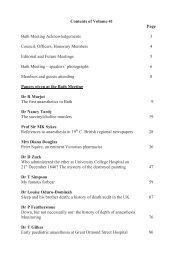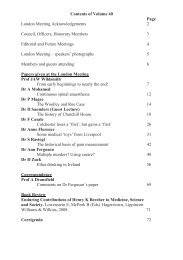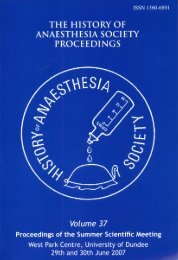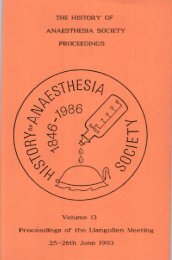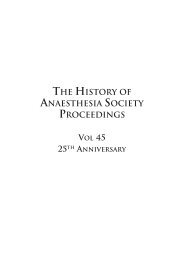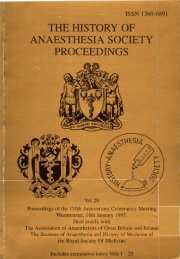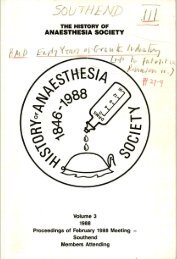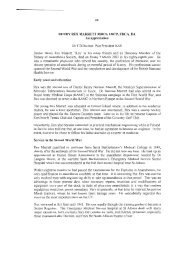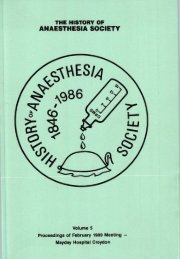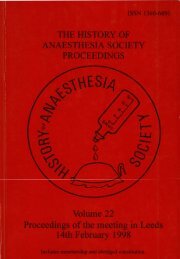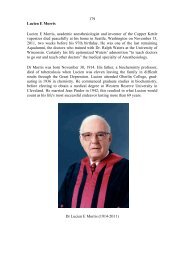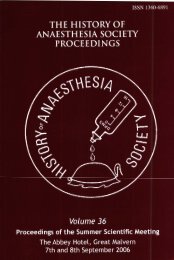Volume 7 - History of Anaesthesia Society
Volume 7 - History of Anaesthesia Society
Volume 7 - History of Anaesthesia Society
You also want an ePaper? Increase the reach of your titles
YUMPU automatically turns print PDFs into web optimized ePapers that Google loves.
'British Medica Journal' <strong>of</strong> June 1950 he reported 8 cases with 2<br />
deaths. Rink,' Hutton and I gave the anaesthetics for 6 <strong>of</strong> the<br />
patients (2 were operated upon in America). These patients were gravely<br />
incapacitated with severe orthopnoea and an exercise tolerance <strong>of</strong> 5-100<br />
yards at the most. Pre-operatively the patients sucked an amethocaine<br />
lozenge and the larynx was sprayed with 10% cocaine imnediately prior to<br />
intubation. The patients were premedicated with hopon and atropine,<br />
induced slowly with thiopentone followed by cyclopropane, oxygen and<br />
ether for intubation and then curare as required. In view <strong>of</strong> their<br />
fragile hold on life it was felt that thiopentone, curare followed by<br />
intubation might well produce a fatal fall in blood pressure. However<br />
in the last case Hutton did use this technique with sEccess. In the<br />
early fifties increasing nmbers <strong>of</strong> mitral, pulmonary and aortic valves<br />
were operated upon. This resulted in shorter operations on much fitter<br />
patients and anaesthesia became fairly standardised. Thiopentone,<br />
curare (and later Scoline) were used Eor intubation followed by nitrous<br />
oxide, oxygen with intermittent curare and thiopentone supplements as<br />
necessary. An analgesic such as pethidine or phenoperidine was <strong>of</strong>ten<br />
used instead <strong>of</strong> thiopentone.<br />
wthenuia in cardlec surgery<br />
The ne main advance was the introduction <strong>of</strong> hypothermia. In 1920<br />
SigelJ5 in Toronto showed that lowering the body tmperature to 30 C<br />
allowed the brain to be rendered anoxic for ten minutes instead, <strong>of</strong><br />
three. 'Ihis permitted an atrio-septal defect to be closed as a<br />
dry<br />
heart' was required for only 5-7 minutes. In order to obtain thls<br />
temperature change three methods were available - surface cooling,<br />
arterio-venous and veno-venous coolinq.<br />
Surface cooling was first described by Swan in America using a cold<br />
water bath. It was a long, messy method but used by Holmes-Sellors at<br />
the Middlesex Hospital until 1960, during which time 200 cases were<br />
operated on. We, at Guy's, preferred to anaesthetise the patient with<br />
thiopentone, curare, nitrous oxide, oxygen, ether to produce<br />
vasodilation, assisted by intravenous chlorpromazine (~argactil) and<br />
then surround the patient with ice packs and fans. Temperature was<br />
carefully measured and the patient was cooled by 1°C every 5 minutes<br />
down to 29'C. If cooling was more rapid ventricular fibrillation was<br />
Liable to ocxur due to temperature differentials.<br />
Donald Ross, who came to Guy's in 1952 as cardiac research surgical<br />
registrar, evolved the methods <strong>of</strong> arterio-venous and veno-venous<br />
cooling. In the former, blood was pumped by the heart fran the fernoral<br />
artery to the saphenous vein via a coiled tube passing through a<br />
refrigerator. For veno-venous cooling the blood was hand pumped Erotr~ the<br />
superior vena cava to the inferior vena cava via the refrigerator.<br />
Tnese two techniques allowed much more rapid cooling as temperature<br />
differentials do not occur. The patient was rewarmed on an electric<br />
blanket.<br />
Surface cooling was introduced clinically about 1952-53 and arteriovenous<br />
and veno-venous methods in 19 4-55 at Guy's, where they were used<br />
for the first time in man. Dred at the Westminster Hospital used



